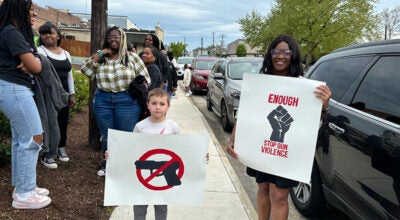SPS outlines fall reopening priorities
Published 9:40 pm Tuesday, July 21, 2020
|
Getting your Trinity Audio player ready...
|
Though four options have been presented for Suffolk Public Schools’ fall reopening plan, only three appear to be under serious consideration.
Parents will be given two choices for their students, though school officials stress plans are fluid and subject to change.
The four options presented publicly earlier this month included a pair of hybrid learning models that have students in school one day per week with either three or four days of virtual learning. The other two are a 100% virtual learning model and a 100% in-person model.
However, when SPS Chief of Administrative Services Dr. Suzanne Rice and Superintendent Dr. John B. Gordon III presented the plan at the July 9 School Board meeting, they stressed that a fully in-person learning plan would not be recommended.
And indeed, on the fall reopening registration form that parents have been asked to fill out by July 24, it asks parents whether they prefer one of the hybrid models or 100% virtual instruction for their child. The online registration form on the division’s website did not present a 100% in-person learning model as a choice.
The decision on the fall reopening plan is expected to come at the board’s Aug. 13 meeting, three weeks before the scheduled start of school Sept. 8. A number of school divisions across the region and state are finalizing their plans, with a number of them, including Fairfax and Chesterfield counties, opting for 100% virtual learning plans as COVID-19 cases have surged around the state in recent weeks.
In the Western Tidewater Health District, which includes Suffolk, Franklin, Isle of Wight County and Southampton County, the seven-day positivity rate for COVID-19 was 11.1% as of July 21. That has been on a steady increase since the end of June, when it was 4.5%. Statewide, the seven-day positivity rate is 7.7%.
District health director Dr. Todd Wagner told Suffolk City Council July 15 that he did not see a way for schools to open for in-person instruction if it has to revert to Phase 2 guidelines, something he said was strongly considered by Gov. Ralph Northam and could still take place.
Rep. Bobby Scott, who chairs the House Education and Labor Committee and represents parts of Suffolk, along with all of Isle of Wight and Franklin as part of his 3rd Congressional District, said at a July 21 virtual news conference that schools and teachers do not have adequate supports in place to reopen safely at this time.
“We simply cannot ask, and we certainly cannot force, state and local officials to fully reopen schools if it cannot be done safely,” Scott said.
Gordon stressed during a presentation at the board meeting that any plans to be implemented in the fall would not look like the plans put into place when schools closed for in-person learning in March. He said the new plans will require empathy, teamwork and “true communication.”
“I want to be very clear here: Parents will not be responsible for the instruction of our students,” Gordon said, “but will need to partner with students and schools in order for learning to be effective.”
Rice noted that learning plans will have to incorporate lost learning, as students will have been out of school buildings for about six months. The instructional task force has recommended a hybrid model of having students attend school for one day in person, with the other days set aside for virtual learning. That task force also recommended that all classes meet daily, rather than on a block schedule, and use “genuine grades” since there will be new learning. Elementary students will likely focus more on literacy and numeracy, and all students would be evaluated using skill-based formative assessments rather than benchmark tests. Special education students in district-wide programs would attend school daily, and College and Career Academy Program students would have in-person instruction twice weekly, alternating between CCAP and core classes.
Parents and board members have expressed numerous concerns, and at least two members — Tyron Riddick and Karen Jenkins — said they favor 100% virtual learning to start.
Rice said any parents who want a 100% virtual option would get it. Virtual learning will take place using the Canvas learning management system, which collaborates with Google Classroom, the i-Ready learning platform for elementary students and Edgenuity for secondary students. All students, pre-K through 12th grade, will have a Chromebook or other electronic device to use, as well as an internet hotspot if they need it.
“There will be some changes in the final outcome in what it will look like in the fall and when we present it to you in August,” Rice told the board, “although we can’t promise that things won’t change from August to September as well.”
Gordon said the division plans to post its health, instruction and overall return to school plans on its website. He said the school division would not bow to political pressure on how to reopen schools, but would focus on putting the health and safety of students and staff first.
“We are not going to put our school community at risk due to what is convenient,” Gordon said. “Suffolk Public Schools will follow (Centers for Disease Control and Prevention) guidelines.”
He said the division is working closely with its health partners to formulate a plan to keep students and staff safe and help prevent the spread of COVID-19.
“We fully agree that we all want our students to be back in school every day,” Gordon said. “But we need to prepare ourselves for a different reality if need be.”
Regardless of what phase Virginia is under when schools are scheduled to resume instruction Sept. 8, social distancing measures along with limited class sizes, cleaning and disinfecting measures will still be in place if students are in school buildings at all.
Rice acknowledged in her presentation that nothing short of having students resume attending school in person five days per week would be ideal. She and Gordon said plans were fluid and subject to change.
She highlighted that the division would not be using Edgenuity as its primary learning platform, acknowledging issues with the platform used by secondary students. She said it would be a supplemental tool in this fall’s plan. However, she said a bigger problem highlighted is inconsistent teacher and staff engagement with students.
“That was a real problem for us, and we recognize that,” Rice said. “And that is going to be something that’s going to be addressed. We are going to come up with (a way) of monitoring this. It will be a very systematic way that we ensure that there’s not only the student engagement, but that the teachers are following through as we have asked them to do.”
As part of its planning, the division and its task forces have been reviewing CDC and Virginia Department of Health guidelines along with plans from other divisions and states, looking at limitations with transportation and calculating classroom capacity with spacing guidelines. It also reviewed state Department of Education guidelines, and it has surveyed staff and parents.
Taking into account having just one person per seat, every other seat, buses would be able to carry no more than 12 students, while classroom desks would need to be spaced six feet apart facing the same direction, limiting classroom capacity. Health guidelines will also require staff to wear face masks, while they will be encouraged, but not required, for students.
“We have to make sure that we are giving anybody who’s going to be given face-to-face instruction the access to get to school for that,” Rice said. “And so we can’t rely on all parents to transport their children because they can’t.”
Rice said common areas such as cafeterias, hallways and gymnasiums would have limited use, and there would be cleaning and disinfecting of all buildings and buses throughout the day. Hallways would likely be for one-way traffic only and marked off for six-feet distancing.
Operational plans will include what will happen when suspected COVID-19 cases appear in schools, with plans to create isolation rooms separate from the school clinics for people who come down with symptoms at school.
Food services will likely be different. She said deliveries to families may come in between bus runs, or they may have to incorporate satellite pick-up locations.
It plans to incorporate child care for staff members, with the possibility of extending that to families of students if possible.





